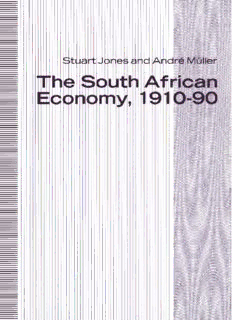
The South African Economy, 1910–90 PDF
Preview The South African Economy, 1910–90
THE SOUTH AFRICAN ECONOMY. 1910-90 Also by Stuart Jones and from Palgrave Macmillan BANKING AND BUSINESS IN SOUTH AFRICA The South African Econont~1910-90 Stuart Jones formerly Head of the Division of Economic History University of the Witwatersrand, South Africa and Andre Miiller Professor of Economics University of Port Elizabeth, South Africa Palgrave Macmillan ISBN 978-1-349-22033-5 ISBN 978-1-349-22031-1 (eBook) DOI 10.1007/978-1-349-22031-1 © Stuart Jones and Andre MUlier 1992 Softcover reprint of the hardcover 1s t edition 1992 All rights reserved. For information, write: Scholarly and Reference Division, S1. Martin's Press, Inc., 175 Fifth Avenue, New York, N.Y. 10010 First published in the United States of America in 1992 ISBN 978-0-312-07507-1 Library of Congress Cataloging-in-Publication Data Jones, Stuart. The South African economy, 1910-90/ Stuart Jones and Andre MUlier. p. cm. Includes bibliographical references (p. ) and index. ISBN 978-0-312-07507-1 1. South Africa-Economic conditions. 2. South Africa-Economic policy. I. MUlier, Andre Leodolff. II. Title. HC905.J66 1992 330.968'05-dc20 91-33633 CIP Contents Preface vii Acknowledgements ix 1 Introduction 1 I Laying the Foundations of the Modern Economy, 1910-33 2 Population and Economic Growth, 1910-33: A Survey 19 3 Agriculture, 1910-33 26 4 Diamonds, Gold and Coal, 1910-33 45 5 Industrialisation Begins, 1910-33 63 6 Transport and Distribution, 1910-33 77 7 Banking and Finance, 1910-33 94 8 External Trade and the Balance of Payments, 1910-33 113 II The Open Economy, 1933-61 9 Population and Economic Growth, 1933-61: A Survey 127 10 Agriculture: Beginning the Transformation, 1933-61 134 11 The Expansion of Mining, 1933-61 150 12 The Industrial Transformation of South Africa, 1933-61 167 13 Transport and Distribution, 1933-61 187 14 Banking and Finance, 1933-61 199 15 External Trade and the Balance of Payments, 1933-61 212 III The Modern Economy Takes Shape: since 1961 16 Population and Economic Growth since 1961: A Survey 227 17 Agriculture: Completing the Transformation, since 1961 236 18 The Diversification of Mining since 1961 257 19 Industrial Expansion and Slowdown since 1961 278 20 Transport and the Retailing Revolution since 1961 305 21 The Financial Revolution since 1961 322 v vi Contents 22 External Trade and the Balance of Payments since 1961 341 Notes 358 Select Bibliography 361 Index 365 Preface This work is intended to be an introductory textbook to the study of the South African economy in the twentieth century. It is not in tended to be a definitive work in the manner of a Cambridge Econ omic History. It does, however, attempt to bring the story up to date and to provide a survey of developments since Union in 1910. It is not intended to be a social and economic history of South Africa. We have, therefore, chosen to focus upon the economy and to avoid, as far as possible, being drawn into the ideological disputes that abound on the question of South Africa and apartheid. We considered a factoral approach to the study, but rejected it on the grounds of impracticability. It would be awkward and cumber some to attempt an economic history of South Africa based on capital, labour and land over an eighty-year period, and well-nigh impossible, given the way the radical left personifies the use of the word capital into some sort of bogey-man. Other works on South Africa, such as that by Jill Nattrass, have a marked bias to labour, which is given disproportionate treatment in her book. The very title of Merle Lipton's book, Capitalism and Apartheid, tells us at once what its perspective will be. Its primary aim is not to examine the evolution of the economy, but the evolution of capitalism and the practice of racial segregation since 1910. We decided therefore to adopt a sectoral approach to our study and to approach it through the primary sector (agriculture and mining), the secondary sector (manufacturing), and the tertiary sec tor (the business services such as transport, distribution, finance and foreign trade). The dictates of space obliged us to exclude the other services, such as those devoted to education, to health and welfare, leisure services, domestic service and the whole range of government services that regulate a modern economy. All of them make import ant contributions to the economy, but not all are of equal import ance. We have chosen to emphasise transport, distribution and finance, because they play such a key role in the development process. Transport and distribution are crucial. Without these ser vices, development simply cannot take place. Their importance has been highlighted in recent years, too, by the heavyhanded action of dictators like Nyerere in Tanzania, who very rapidly destroyed an efficient distribution and banking system, and Kaunda in Zambia, vii viii Preface who has done much the same there. The wars in Mozambique and Angola have shown how fragile a transport system can be. The damage done to wholesaling and distribution by African socialist dictators has been immense and has brought enormous hardship to their people. We wish to emphasise the importance of the distribu tion system and to argue that its importance increases relatively, as the economy grows larger and becomes more complex. In a techno logical age, education is also becoming steadily more important, though the direct benefits are more difficult to quantify. If we have offended by omitting important services, we apologise. We would welcome a book devoted to the evolution of the tertiary sector in all its aspects. One final caveat. Converting monetary prices into constant ones is not an exact science and adjusting them according to retail and wholesale prices is admittedly arbitrary. It is intended only to give a reasonable impression of the real changes taking place in the South African economy. Stuart Jones is responsible for these figures. Acknowledgements The authors would like to thank all those kind persons who assisted with the typing of the manuscript and especially the two Pats, Pat Brent and Pat King, who had to meet deadlines and decypher our hieroglyphics. ix
Description: